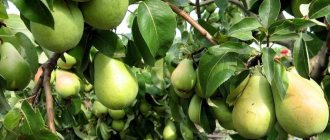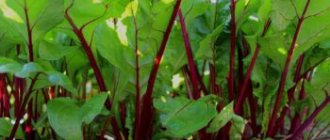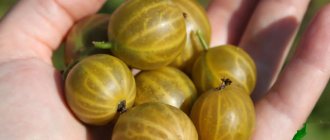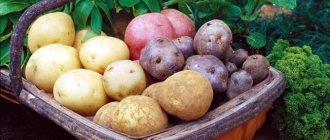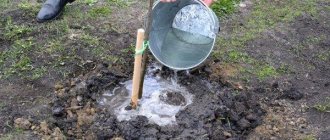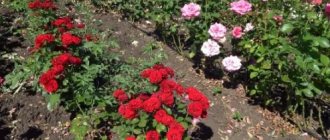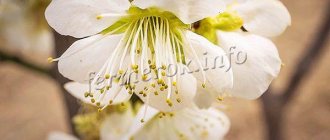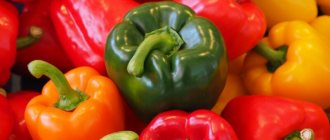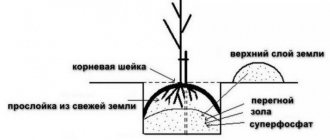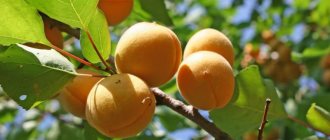Gardening » Pear
0
1471
Article rating
Kira Stoletova
Over the past few years, columnar trees have begun to be grown in the Moscow region. The reason for this is the appearance of the plant itself and the fact that in such regions of the country it is important to value even the smallest plots of land. Let's consider why columnar pears are interesting for the Moscow region.
The best columnar pears for the Moscow region
Features of columnar crops
Columnar trees are compact in appearance. They are often classified as dwarf crops. This name of the tree is due to the fact that its shape is similar to a column, i.e. the side branches are located close to the main trunk. The leaves are green, oval in shape. The description indicates that all varieties of this category are characterized by a rich honey aroma and juiciness of the fruit. They do not require special care, so everyone can plant them in their own garden plot.
This series is characterized by an unusual appearance, so it is often used to decorate a garden plot or yard. Such pear crops can be summer, winter and autumn. If you want to eat pear fruits for 6-8 months, you need to plant plants that bear fruit in different seasons.
Trees begin to bear fruit in the second year after planting. Excellent productivity indicators are noted. In the first few years, you can collect about 50-80 kg of selected products from 1 plant. Over time, 4-5 years after planting, the yield increases several times. Such crops are resistant to negative environmental factors (frost or drought). It should be noted that they have a good immune system in relation to diseases.
Agricultural technology for planting columnar pear
The technological process of planting seedlings of dwarf varieties in the ground is described below:
- The planting hole is prepared in the spring - a week before planting; its dimensions are 80 cm deep and 60 cm wide.
- The distance between holes is 50 centimeters, between rows - 1 meter. These numbers are the key to the health of future trees.
- Water is poured into the prepared hole, and after absorption, humus and sand are added.
- Before placing the seedling in the hole, its root system must be moistened with water.
- The bottom of the hole is partially covered with soil flavored with potassium and phosphorus fertilizers.
- A seedling is placed on top of the amended soil and the roots are carefully straightened.
- The soil remaining after digging the hole is poured into the hole, compacted by hand and watered.
Dalikor
This variety is considered early winter. It can often be found in the Moscow region. Harvest should be in mid-October. If you store the fruits at the right temperature (about 8-10°C), they can be stored without loss of taste and marketability for 4-5 months.
The weight of an individual fruit is 500 g. The description indicates that this variety is characterized by high yield: about 35-40 kg per tree. The outer shell is light green, with a slight red blush. The pulp is juicy, without a watery structure. In cross-section, the pear has a rich cream color. The taste is excellent, the fruits are sweet. Astringency is absent at the genetic level.
How to properly form the crown of a pear
The method of pear formation is chosen individually, depending on the variety, growing region and care capabilities. The most commonly used schemes are:
- Sparsely tiered. Used in most regions, it is the most common among gardeners. According to this scheme, three fruiting tiers from several skeletal branches are formed on one central trunk. The main positive quality of this method of formation is the ripening of a high yield, however, the significant height of the tree creates great difficulties when working with the upper tier of the crown.
- Cup-shaped. This scheme for the formation of a pear crown involves the laying of one fruit tier, above which there is no central conductor. The bowl is formed at a height of 0.5-0.6 m from the ground level from four skeletal branches evenly extending from the trunk. You can give them larger angles of departure using twine guys. The good thing about the bowl-shaped pattern of pear formation is that the tree does not grow tall, and you can work with it without using a stepladder or ladder. The center of the crown is well lit, there is no air stagnation in it, and this has a positive effect on the quality of the fruit. The disadvantage of the bowl-shaped scheme is the reduction in overall yield.
- Spindle. This method of formation allows you to get a short, slender tree, very decorative in appearance. With this method of formation, tiers are not laid; the entire trunk is evenly overgrown with lateral branches with wide angles of departure. Excess shoots are removed. The necessary branches are given a horizontal position using guys or spacers. The spindle-shaped pattern allows you to increase the density of planting fruit trees and the decorative appearance of the garden as a whole. It is used when growing pears on low-growing or dwarf rootstocks.
There are many other ways to shape the crown of a pear using pruning. They can be found in specialized literature.
How to form a pear crown on a young tree
The formation of the crown using pruning in a young pear tree begins immediately after planting the seedling. At this time, the gardener must clearly determine for himself which particular scheme he decides to use. The further north the growing region is, the lower the future fruit tree should be, this will reduce its chances of freezing in winter. The chosen scheme should be strictly adhered to until the crown is completely formed.
How to shape an adult pear
After 4 years of life, the pear tree is considered fully formed. Further pruning should help maintain the crown in the required dimensions and limit upward growth. An adult, fully formed pear tree only needs to be regularly cleaned of plant debris in the form of dried branches, thickened growth removed and periodically rejuvenated.
Carmen
Varieties vary in taste and color
This variety of columnar pear for the Moscow region was bred in Russia. Was obtained as a result of crossing Williams and Blank's daughter. Large fruits can reach a weight of 250 g. The outer shell is light yellow. 40% of the fruit area is covered with a brown blush.
The pulp is dense, not watery. The taste is pleasant, sweet. Among the main disadvantages, low resistance to frost, late ripening (late October) and low yield should be noted. The advantages include such characteristics as undemanding to the soil and planting method, resistance to scab.
Description of the dwarf pear
The compact, low tree is valued for its good survival rate and fairly easy care.
A tree grown from a seedling begins to bear fruit in the second year. In the first year, the columnar pear will produce a harvest of up to 3 kg of large fruits. All varieties of dwarfs are characterized by winter hardiness and unpretentiousness to the soil. Some trees grow 2.5 meters, mostly the columns grow up to 1.5 meters, but are covered with fruits. The pears seem to be stuck to the trunk. In fact, they are tied on small branches. The crown is not formed.
Advantages:
- unpretentiousness;
- productivity;
- resistance to adverse conditions;
- compactness;
- high yield.
The tree requires regular pruning, abundant watering, and feeding of an adult pear.
The tree will feel good in a cramped area, as long as the north wind does not make it shrink. The best planting material is ready-made columnar pear seedlings purchased from a nursery.
The plant can be propagated from green cuttings. A seedling grown from seeds must be grafted, otherwise it will grow wild.
There are few varieties of dwarf pears, but they are varied. We offer columnar pears of various ripening periods, from early summer pears with a short shelf life to winter pears that gain flavor as they sit. The fruits are used fresh and in all methods of preservation.
However, dwarfs do not live long. Fruiting can last 7-15 years. The duration of the commodity period is influenced by the conditions of detention.
Academician Yakovlev's favorite
This ideal pear variety for the Moscow region was obtained by crossing varieties such as Esperena and Bergamot. This variety is characterized by the possibility of self-pollination. To increase productivity, the crop should be planted near its pollinators - Daughter of Blankova and Esperen.
Fruiting occurs at the end of summer, 5 years after planting in a permanent place. Excellent productivity (about 50 kg per tree) and resistance to low air temperatures are noted. The weight of 1 tasty and juicy fruit is 200-400 g. The surface is characterized by a yellow color, with a slight burgundy blush. The taste is sweet and the aroma is slightly reminiscent of quince.
Features of growing pears in the Moscow region
The climatic features of the Moscow region and its environs are the following factors:
- pronounced seasonality;
- possible severe frosts;
- periodic droughts in summer;
- thaws and recurrent frosts.
Pear varieties that will be grown in a given region must meet a number of requirements:
- be resilient;
- have good immunity;
- tolerate return frosts.
Honey variety
One of the best columnar pear varieties for the Moscow region is Honey Pear. The fruits of this crop are rich yellow in color, without blush or spots. The weight of the fruit is 400-500 g. The pulp is juicy and pleasant. The taste is sweet. The aroma is characteristic of pear products.
The tree begins to bear fruit 3 years after planting in a permanent place. From 1 tree you can collect about 80 kg of products. The harvest falls at the beginning of September. The species is characterized by resistance to frost, drought and undemanding soil. The only drawback is that the collected products quickly lose their marketability and taste (they can be stored for no longer than 2 months).
Reviews from gardeners
No less popular in the Moscow region and the central zone of our country are the varieties “Severyanka” and “Firefly”, as well as “G-322”. Columnar pears generally receive positive reviews and high ratings from amateur gardeners due to the fact that even an adult and productive fruit tree occupies a fairly small space, which allows for the most efficient use of the entire planting area.
The most popular columnar varieties are characterized by excellent taste and a fairly pronounced aroma. However, it is important to monitor the forecast and use winter shelter if necessary. Almost all experienced domestic gardeners recommend providing such fruit plantings with good insulation in the winter, after removing which, in early spring, proper pruning, fertilizing, and treatment of the plant from pests and pathogenic microflora is carried out.
Autumn Dream
This variety belongs to hybrid crops. It was obtained by crossing varieties such as Dikanka and Kopeechka. Ideal for growing in the Moscow region. Such trees are not grown as often as others. This is due to the fact that the fruits of such a plant are small in size. The surface of the pear is covered with small brown spots. The products are used to make jam, juices or other desserts.
Fruiting is observed 5 years after planting. The harvest takes place at the end of October. Individual fruits can reach a weight of 400 g, but the standard weight is 200-250 g. The taste is pleasant and sweet. The pulp is juicy, but not watery.
Care
Proper care of columnar pears of various varieties includes the following activities:
- annual pruning of side shoots to the level of the second bud. The stem is not cut;
- The irrigation regime for young shoots is more intense than for mature specimens. The roots should not be flooded to prevent putrefactive processes from developing;
- removing flowers in the first year of growing season promotes the development of the root system;
- in the first half of summer, organic fertilizer based on mullein or chicken is applied. After the leaves bloom, three times foliar feeding with urea solution is performed with an interval of 2 weeks;
- In order for a tree to bear fruit and produce a one-dimensional harvest, it has to be normalized by removing excess greenfinches;
- for the winter, cover the trunk with covering material and tie spruce branches on top. If there is little snow, winter hilling is carried out by raking snowdrifts around the tree.
Although most cultivars have good immunity, spring treatment with Bordeaux mixture and fungicides should not be neglected.
It is definitely worth growing a columnar dwarf tree with delicious, aromatic fruits. After all, planting and caring for this crop is simple.
Sapphira
This variety ripens at the end of October. The tree begins to bear fruit 3 years after planting. In order for the fruits to reach consumer maturity, they are picked at the stage of technical ripeness and left in the basement for 15-20 days. You can store the products in this condition, without loss of taste and presentation, until December.
The weight of the pear is about 300 g. The surface of the fruit is a rich yellow hue. The inner flesh is beige. The taste of pear is rich, sweet, pleasant. The pulp is juicy. This species is not only resistant to sudden changes in temperature, but also to most common diseases.
Useful properties of pear
Pears contain less sugar than apples, but the pear tastes sweeter. The presence of large amounts of fructose has a beneficial effect on the activity of the pancreas.
Pear is a low-calorie product; 100 g contains only 42 kcal. Therefore, it is useful for people watching their figure or on a diet.
The fruit contains:
- vitamin A;
- B vitamins;
- ascorbic acid;
- tocopherol;
- phylloquinone;
- mono- and polyunsaturated fatty acids;
- saturated fatty acids;
- phytosterol;
- selenium;
- iron;
- magnesium;
- manganese;
- sulfur;
- iodine;
- copper.
The essential oils that pear contains boost immunity, eliminate infectious and inflammatory processes, and help improve mood. Organic substances have a positive effect on digestive and metabolic processes, fiber reduces the amount of “bad” cholesterol, giving a feeling of fullness. And the high tannin content is a good remedy for diarrhea. But keep in mind that overripe or spoiled fruits can lead to stomach upset.
The plant fibers contained in the pear activate the excretion of bile. Therefore, experts recommend eating pears for liver diseases.
Severyanka
Severyanka is often found in the gardens of the Moscow region. The tree begins to bear fruit already 2 years after planting in a permanent place. Every year it produces an excellent harvest (about 60 kg from 1 tree). Harvesting is carried out in late summer or early autumn. The only drawback of such a pear should be considered the fact that, during the period of maturity, it begins to crumble.
The fruits do not have a pronounced aroma. The taste is sweet, a little cloying. The weight of a pear, on average, is 300 g. The peel is dark yellow, with a slight brown blush, which occupies 30% of the entire area.
Should I plant a “columnar” pear?
Some resources on the Internet indicate the famous breeder of columnar apple trees, Candidate of Agricultural Sciences Mikhail Vitalievich Kachalkin as the creator of columnar pears, although he completely denies even the existence of such plants.
Columnar pears, plums and apricots. Myth or reality?
Are there columnar pears?
Recent Entries
5 working ways to use tar in the garden 7 indoor plants that help you get married even in adulthood Indoor plants that can bloom in trouble
If, contrary to everything that has been said, a gardener decides to plant a “columnar” pear on his plot, he should pay attention to the general recommendations for planting and caring for this type of tree. It may be worth checking with the seller about the nature of the rootstock and taking into account possible nuances of growing the plant.
In fact, it’s not at all difficult to form a pear with a compact crown, the height of which will not exceed two meters, and the width will be about 1.2 meters. Such trees are successfully grown for production purposes. This crown shape is called dwarf pyramidal. True, caring for such a pear will be somewhat more intensive than for a tall one, since it will require:
- summer pruning;
- removal of powerful vertical shoots;
- timely harvesting of fruits.
It is possible to form such a tree crown if a varietal cutting of a pear was grafted onto a cherry plum. This rootstock successfully maintains a balance between the renewal of fruit formations and constant fruiting.
Seedlings are planted during the dormant period in spring or autumn. For a single tree, stakes are installed to secure the young plant. If a whole row of young trees is planted, a trellis is made to tie them up with wires stretched at a height of 0.45 and 0.9 meters. A distance of 1.5–1.8 meters is left between trees, and about 2 meters on fertile soils. The row spacing is 2 meters.
The formation of the crown begins immediately after planting the pear in its permanent place. On the stem of the tree, a bud is identified at a height of about half a meter from the ground, located on the side opposite to the grafting site. A cut is made above this bud, which is treated with garden varnish. Over the summer, a pear will form 4–5 shoots.
The formation of a dwarf pyramidal crown of a pear begins in the first year of planting a tree
In the spring of next year, the vertical shoot is pruned, leaving about 0.25 meters of its length, above the bud located on the side opposite to the previous pruning. This pruning stimulates the growth of new side shoots.
The side shoots that grew last year are also pruned to a bud, which is directed downward and located at a distance of 0.2 meters from the trunk.
In the summer of the same year, side shoots that are not needed to create skeletal branches are shortened, leaving only 7–10 centimeters of growth, that is, no more than three leaves. Second-order shoots, that is, those extending from branches that grew last year, are cut off, leaving 1 leaf. The conductor (central vertical shoot) is not cut.
Formation of the crown of a young pear in the second year
In the third and subsequent years, the conductor is cut, leaving 0.25 meters of its length, as in the previous year. The growth that was formed as a result of last year's summer pruning is cut off above a well-formed bud. All powerful vertical shoots are removed completely.
In summer, all side shoots are shortened to three leaves, shoots of the second order - to one leaf, shoots that continue the skeletal branches - to six leaves.
The third year of pear tree crown formation
On an adult tree that has reached two meters in height, in the summer the central conductor is shortened to the entire length of the current year's growth. Strong shoots directed upwards and side branches that have grown beyond the crown and interfere with neighboring pears are also pruned, and the fruits are thinned out.
Maintaining crown shape. Pruning a mature tree
The crown formed in this way will occupy an area of slightly more than one square meter, which, of course, is more than the area allocated for a columnar tree, but is quite acceptable even for small garden plots.
Where to buy pear seedlings?
You can buy pear seedlings by mail in our online store KFK Fruit Garden.
By purchasing seedlings in our online seedling store, you can be sure of their quality. With proper care, our seedlings grow into strong and healthy trees that produce high yields.
Placing an order is quite simple. Go to the Store, select the Fruit Trees and Pears section. Place the required variety and quantity into the cart, then place your order. Our specialists will contact you to confirm your order.
We know how much you love nice gifts! Therefore, as a bonus, we are giving a free consultation on the care and cultivation of pears.
If you place an order over 5–10 thousand rubles, you will receive a nice discount! Don't hesitate, place your order soon!
The best varieties for the Moscow region
In the Moscow region and the Moscow region, early and mid-ripening pear varieties have proven themselves best. Trees with late ripening dates will most likely not have time to ripen, so they are not suitable for this climate zone. All pears are conventionally divided into three categories, classification is carried out according to harvest time. Thus, a distinction is made between summer, autumn and winter pears. In the Moscow region, it is preferable to choose pears of summer and autumn varieties.
You may be interested in: How to insulate a pear tree for the winter, practical recommendations
Suitable varieties for growing:
- Chizhovskaya represents a kind of standard for this fruit when grown in the Moscow region. Summer varieties with amazingly beautiful and juicy fruits. Ideal for beginners.
- Lada also boasts low maintenance and consistently high yields. The fruits are very large and fragrant, summer ripening.
- Cosmic - a variety with strong immunity to scab and common diseases. Ripens at the end of August, the fruits are of high quality and consumer characteristics.
- Cathedral is also a summer variety. It ripens in early August and is characterized by stable fruiting.
- Naryadna Efimova is one of the most popular autumn varieties of pears. It is characterized by high yield and excellent shelf life. The fruits are stored for three months; the variety requires winter shelter.
- Velesa will also delight owners with large, aromatic fruits that are not inferior in juiciness to summer varieties.
- Otradnenskaya is distinguished by its early fruiting period (in the fourth year after planting), as well as the excellent taste characteristics of the fruit.
- Muscovite is characterized by medium ripening periods and high productivity. It does not require special shelter and tolerates the climate of the Middle Zone well.
- Tonkovertka is a fruit of excellent quality, but only for fresh consumption. The variety is characterized by amazing frost resistance and is suitable for growing in the Moscow region.
- It is not for nothing that Marble is considered one of the most successful varieties of domestic selection. The fruits are very large, of good quality and can be stored for a long time.
- Autumn Yakovleva. An excellent high-yielding variety with high-quality fruit characteristics and good winter hardiness.
The distance between trees at the time of planting is determined by the size of the crown of the future tree (usually from 4 to 6 meters), so in small areas it is preferable to plant columnar pear varieties. For them, it will be enough to leave 90 centimeters between the trees. Dense plantings are more difficult to process; in addition, one of the features of columnar varieties is increased requirements for growing conditions, therefore, with a very frequent planting pattern, the seedlings will experience a deficiency of nutrients.
Features of care and an overview of popular varieties of pears for growing in the Middle Zone and Moscow region are shown in the video clip.
You may be interested in: When to plant tulips in the fall in the Moscow region and how to do it
How to plant a pear
The soil for pears must be nutritious, medium loose and slightly acidic. Too acidic environments are alkalized with lime or wood ash. For sandstones, the addition of clay and chernozem is allowed, but the best place for growth will be loamy soils, additionally fertilized with humus or peat.
Mineral root dressings are used in very limited quantities so that the plant does not get burned. For one seedling, fertilizing is done at the rate of 200 grams of superphosphate, nitrophoska and 100 grams of potassium nitrate. If organic matter is used, you can mix the soil from the planting hole with a bucket of humus or compost. Only rotted chicken and cow manure should be taken, no more than half a bucket per plant.
Landing algorithm:
- A hole is dug 40 - 50 centimeters deep. The width of the hole is determined by the roots of the seedling and is usually about half a meter in diameter.
- A drainage layer is laid at the bottom of the hole. In this capacity, you can use expanded clay, small fragments of brick, crushed stone and gravel.
- A layer of fertile soil mixed with mineral or organic fertilizers is sprinkled on top.
- The roots of the seedling are carefully inspected, old and dried parts are cut off, as well as places damaged by rot.
- The seedling is installed vertically upward, the roots are well straightened around the circumference of the hole. At this stage, a reliable support is driven into the side, preferably a wooden peg. Metal reinforcement and other suitable materials can be used.
- The hole must be filled with fertile soil, compacted thoroughly and watered with warm water. When planted correctly, the soil in the tree trunk circle should not contain internal voids, which lead to the development of diseases and freezing of the roots.
- Watering is repeated several times at intervals of several days. This also contributes to the compaction of the soil and the safe wintering of the plant.
- The root circle is mulched with straw, sawdust or peat. This will help retain moisture and protect the root system from freezing. When planting in spring, a layer of mulch will also provide protection against weeds.
Preliminary preparation of the seedling consists of keeping it in warm water for 24 hours. For better rooting, stimulating solutions are used, as well as folk recipes. Typically, planting dates for the Moscow region vary from mid-September to mid-October. There must be at least a month left before real frosts so that the seedling has time to take root. At the same time, planting too early can lead to the fact that the tree begins to actively develop the above-ground part and, with the onset of cold weather, simply freezes out.
You may be interested in: Blueberries: planting and care in the Moscow region for a good harvest
